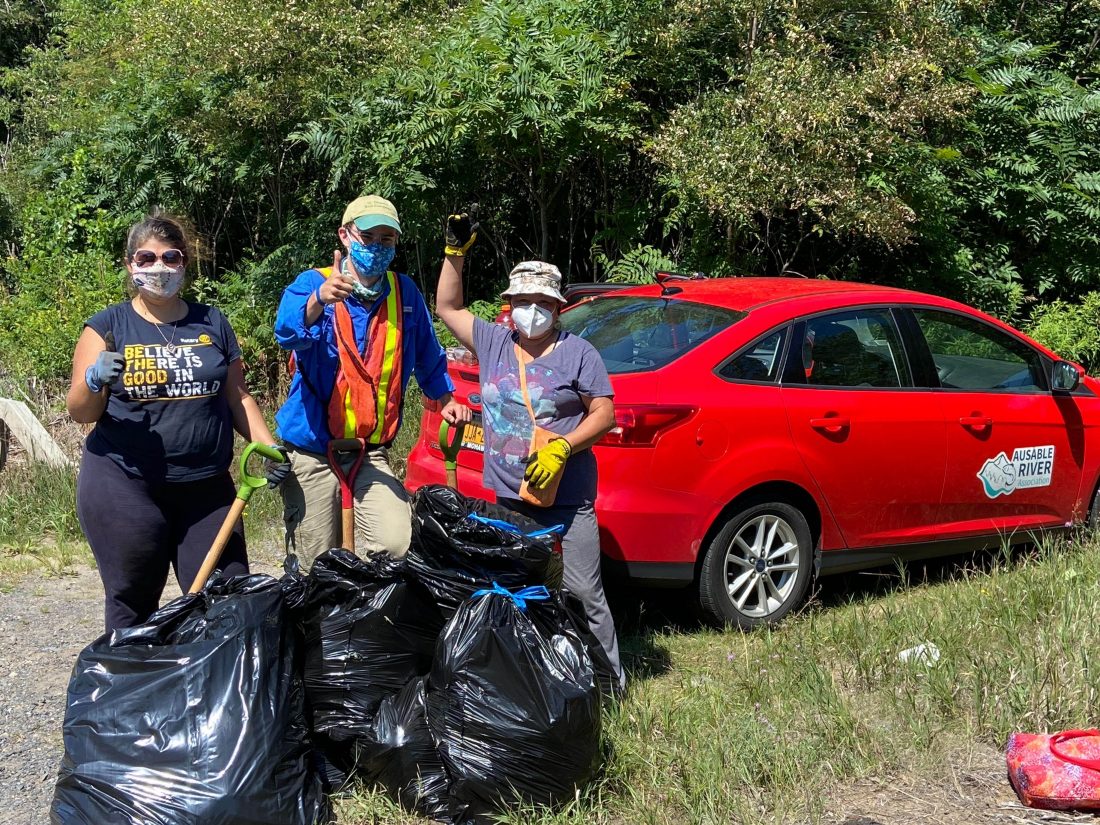AUSABLE WATER WISE: Invasive species on the move this year in the Adirondacks

Ausable River Association staff, along with the Rotary Club of AuSable Valley members, help remove a patch of purple loosestrife, another invasive species, in Keeseville. (Photo provided — Knut Sauer)
They’re getting closer. They sneak under your kayak seat when you’re not looking and hide, undetected, in your firewood as you pile it in your trunk.
Sometimes they lure you in with their vibrant colors, and other times they’re barely visible. You may have heard about some of them, but aren’t sure how they can harm you, or what part of your daily life they threaten. We’re not talking about venomous snakes or poisonous berries. This threat goes by a less malicious, but equally worrisome name: invasive species.
Invasive species are gaining ground in the Adirondacks this summer. The first case of the emerald ash borer was confirmed in early August. A few weeks later, the second case of hemlock wooly adelgid was discovered. Eurasian watermilfoil is spreading in numerous ponds, lakes, and rivers. And this is just the tip of the iceberg. If you feel overwhelmed hearing news stories like this, you’re not alone.
Thankfully, it’s not necessary to remember and identify all non-native plants and animals. There are practical steps you can take to minimize the spread of invasive species and help protect the areas you love.
In the village of Lake Placid, freshwater is central to our way of life, so we’ll focus here on aquatic invasive species (AIS). These are organisms that live in fresh or saltwater, have spread to locations where they do not naturally occur, and cause harm to the economy, environment, or human health. They also negatively impact outdoor recreation experiences. You may hear AIS referred to as aquatic hitchhikers, since they can be transported through recreational activities.
When you try to paddle though dense roots of Eurasian watermilfoil, or wade into a lake with razor-sharp zebra mussels clinging to the shore, you’re potentially picking up an unwanted traveler.
If you are an angler, or just like going for a swim, the best way to prevent the spread of AIS is to check, clean, and dry your gear between waterways. First, check your equipment and clothing for live organisms, particularly in areas that are damp or hard to inspect. Next, clean and wash all equipment, footwear, and clothing thoroughly. The Ausable River Association makes this easy with their wader wash stations at popular fishing access points along the West Branch AuSable River. Lastly, dry all equipment and clothing for at least 48 hours if possible, since some AIS can live for many days in moist conditions.
The guidelines are similar for paddling and boating. First, clean off visible aquatic plants, animals, and mud from all equipment before leaving the water access. Free boat wash and decontamination stations located throughout the Adirondacks greatly help with this step. Next, drain the watercraft bilge, livewell, motor, cockpit, or other water containing devices before leaving the water access. Lastly, dry the boat, trailer, and all equipment for at least five days, or completely wipe with a towel before reuse.
OK, you talked us into it. We’ll give you a few bonus guidelines for good measure. Remember the emerald ash borer that we mentioned at the beginning of this article? Help prevent the spread of this tree-killing beetle by purchasing and burning firewood locally. When you transport firewood, you increase the chances of invasive wood-boring beetles spreading to new locations. Oh, and let’s not forget about hemlock wooly adelgid. Do a quick internet search to learn more about this invasive, and then download the iMapInvasives mobile app to help scientists with early detection.
It doesn’t take much time or effort to make a big difference. Together, we can protect the water and natural landscapes we love.
It’s the final days of our summer matching challenge. We’re $11,000 short of our $40,000 goal. Our work on road salt impacts, invasive species eradication, community flood resilience, and native species health depends on our success.
Go to www.ausableriver. org/give and make a difference for freshwater health.




